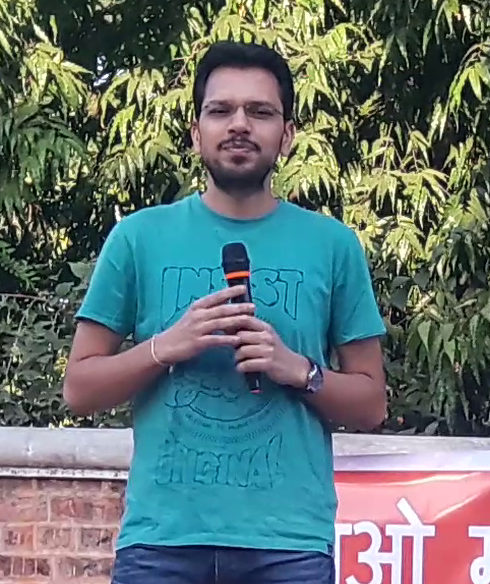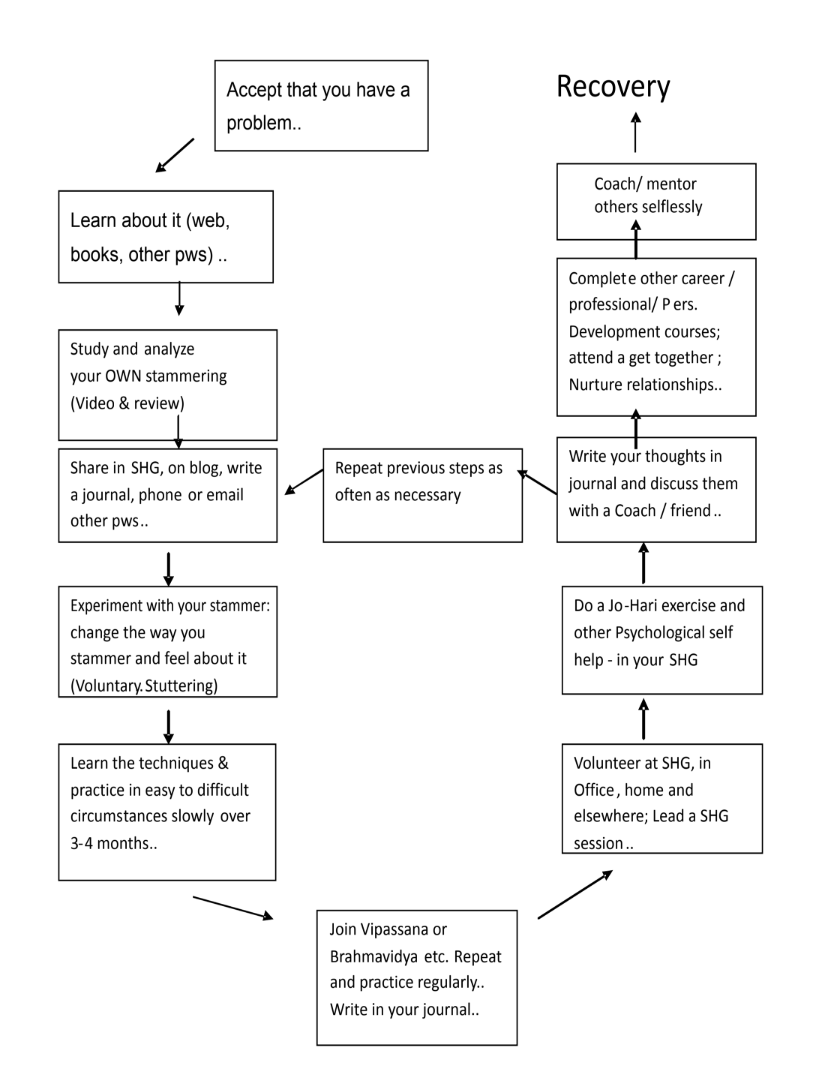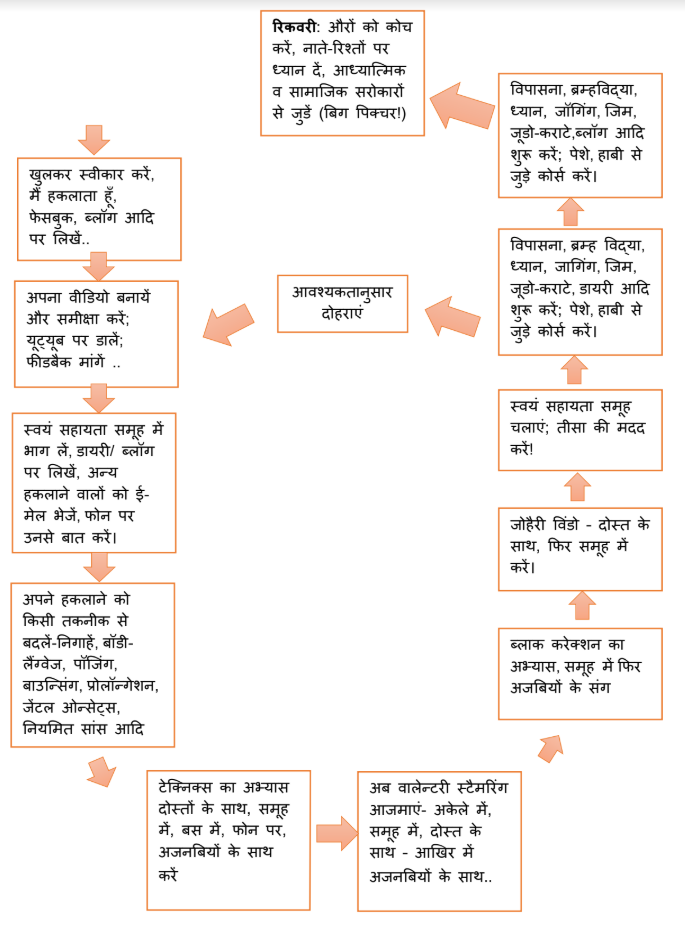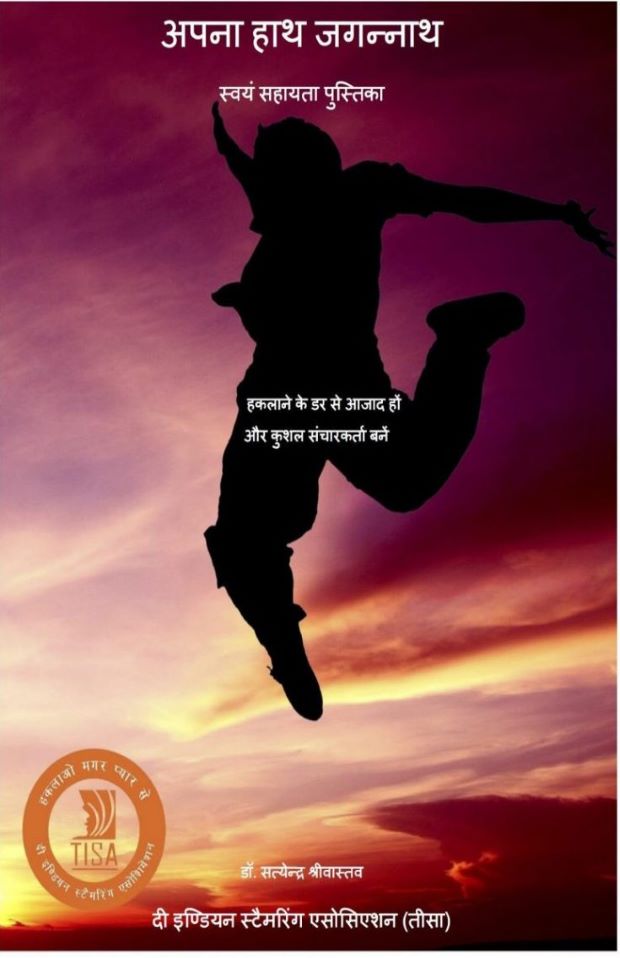
What You Can Do
If you stammer, you can make up your mind to help yourself. Many have done so. Is self-help approach better than therapy? Check the next snippet.
If you have a little self-discipline and courage, you can easily succeed – especially if you begin early: because you can not learn swimming when you are drowning. That is not the time to learn anything. Lastly, if you can focus on the right goal (- to become a good communicator-), you can certainly succeed.
PWS or Hakla?
People who stammer (or stutter, same thing) has been abbreviated to PWS. Some prefer “pws” than other names like Hakla in Hindi, Fappa in Garhwali, Bhakbhako in Nepali, Begayer in French, Tatamudez in Spanish, Dikwaya in Tamil… What is in a name, as Shakespeare said, a stammerer by any other name will still sound as cute!
Actually, pws is based on “People First” principle: first people, then their diversity or issue – like people who stammer, people who use wheelchair etc. (wiki). Another angle is: words like Hakla have become pejorative. It is time that we “recover” these words by de-linking them from shame, oppression, fear – by using them like any other harmless word. “Hakla Hakla” song by Mumbai SHG is an attempt in that direction.
Are you alone?
All of us here at TISA, stammer – happily! In India, 1 crore plus people stammer. In the world, 6 crore and more stammer. YOU ARE NOT ALONE. But it does feel lonely since sharing your feelings with others does seem difficult. When you need all the social support, that is the time when you just can not socialise! This is where self help groups (physical or online) come handy. Remember, you dont have to speak always, in order to be social. Sometime listening and smiling is the best input.
Next, what can you do ? You can learn from other stammerers. Because many pws over the years, do learn from their difficulties and develop lots of problem solving skills. You too, with some help, become the expert on your own issues and ways to handle them.
Self help, better approach?
1. Therapy promises FLUENCY but ends in relapse almost always. So, people keep going back again and again for more of it. With every relapse, this idea becomes deeper: I am to blame for this. I will never be a “normal” person. Something is deeply wrong with me. Thus, years are wasted.
2. Self help approach, in stead, pursues a realistic and practical goal: communication in all circumstances, even if it is with a little disfluency. A “little disfluency” is part and parcel of NORMAL speech, if you notice presenters and speakers on TV and elsewhere carefully. They stumble and carry on with an “excuse me”. Because they have something interesting to tell! This is the goal, which we can accept if we understand that curing the mindset is the real work involved here. Remember, Stammering is 99% psychological.
3. Self help works with interactive help from others, just like you – not in a clinic, 121 with a doctor. So we develop social skills at the same time as Communication skills. Soon, you end up with a supportive community and lots of friends.
4. Working on your own, you develop problem solving skills and emotional intelligence, which help you in the long run. Stammering is a long term issue and you can not run to an “expert” every time you have a job interview. Self help approach empowers you.
5. In the long run, you begin to see stammering as a DIVERSITY, your peculiar way of speaking and feeling- not a “speech disorder” which must be cured at any cost – or endured silently for the rest of life. You even start to see the bright side of stammering, the opportunities.
But TISA always respects your decision to opt for a therapist or any other modality.
99% Psychological?
Stammering begins with certain genes, which cause different ‘wiring’ in the speech area of our brain. While other children get over their normal disfluency between 2 to 5 years of age, we continue to struggle with speech. As we come to higher classes, unthinking reactions of others makes us develop an elaborate mindset based on fear, sensitivity, shame, alienation, guilt etc. : Speaking is difficult; I must be careful; This word is difficult so let me use another word; people dont like me, so why should I go out of my way to make friends etc.
Over the years, we become so CAREFUL that we bypass the LIFE itself: we make no friends, we take no risk in career or education or relationships. We blame every setback to “my stammering” and fail to learn from the mistakes. This mindset does more harm to us than stammering itself. This is why, the goal of self help is to recognise this mindset and step out of it- through desensitization exercises like stammering interview, voluntary stammering etc. (more)

Recovery: A Tentative Path
Recovery from stammering can be a long journey but a homeward journey is always worth the trouble. Many of us in TISA have undertaken this trip and have reached a point where we raise hands, ask questions, offer solutions, volunteer, conduct workshops, talk to strangers (“beautiful” or not!) and engage with life at a deeper plane. In the two side infographics we share some common milestones or stages in this journey. Your journey will be different, which is fine- as long as it takes off.

Have you lost hope?
At times it may seem that you are fighting a losing battle. But NO! You can reverse the trend; you can refocus, recalibrate and reconnect with those who have helped themselves. Learn from the Pros! But you have to take the lead and the “ownership” of your own well being. Here are some steps:
Beginner Steps
- You can talk (or write) more about yourself and your stammering. You can send us your brief bio and a photo. You can share your thoughts on the blog. Many people have done this in last ten years and have felt the instant benefits.
- You can learn more about stammering. (HMPS video, AHJ book- Hindi and English- links on the left)
- You can join a nearby self help group (check this list). If there is no SHG where you live, you can consider starting one. You need just one pws to begin with: YOU! Here is how you can go about it.
- You may check out online conferences and groups (link) which meet most nights on Google groups or skype. You can join one of the whatsapp groups (Amit: 9654176670 ).
- You can browse this video list: see people stammering and sharing something very interesting. Then, you may talk into your web-camera and upload your video on youtube – and send us the link. This is sure way of getting feedback on your communication and making friends online. This is also a very nice way of seeing how you communicate.
- Keep checking this site and attend our next event: you will meet many interesting people, make friends and learn useful things – techniques too, if you want to.
- Whatever you do- remember: stammering is a social problem (we don’t stammer when alone) and therefore social activities benefit a lot. Secondly, if stammering has developed over years, it will surely take some time to un-learn it. Have patience and work consistently for some months or an year. Don’t give up.
- Finally, NOTHING will change if you keep browsing internet! Get up and take that first step. It feels frightening but it is not that bad. Talk to a stranger. Record your video. Put it on the youtube. Call old friends. Join a SHG… Anything.
In Fifties?
If you are in your forties and fifties, you have probably gone beyond the battles for getting a job and a wife/partner. May be, a little hurt, a tinge of sadness, is still there, deep down in your soul. You too can do something: Get involved. Listen to a young stammerer and encourage her or him. Counsel them about education, career and relationships. Don’t send them off on a wild goose chase after “cure”- because there is none at physical plain. Instead, share your own story and tell them that other things in life matter too: listening carefully, excelling at the job, willingness to learn new skills, spending time with friends and having fun etc.
Are you a woman?
If you are a woman who stammers- we can understand the agony and the troubles of growing up as a girl, in a patriarchal society and dealing with stammering on a daily basis. But have courage! TISA has some experienced women too who can counsel you and help you. To begin with, start talking about it, like this and this. If possible, start meeting other WWS (link) – in person or on skype/ phone/ whatsapp. Such meetings can transform you, besides being so much FUN. See the video below. Contact our women’s wing at: kartavayadiaries@gmail.com
On home page, see the bottom row: psots by WWS and get some ideas.
What about "therapy"?
We discuss and share about self-help, which is quite effective and accessible for many of us. We neither offer “speech therapy” nor act as a referral center. Generally speaking, going to a Therapist in a government hospital may be your next best course of action in this country -in our well considered opinion. Here is our recent post discussing this question in some depth. Whatever you do, take an informed decision, stick to it, give yourself some time for change to take place. And check this too – Happy Losers!
Why is there no cure?
Speech therapist also treat a condition called – Misarticulation, rather easily compared to stammering. Here, they understand the underlying reason: the person’s tongue or lip touches wrong part of the mouth and therefore the wrong sound comes out, like Tala for Kala. So, they teach the person, how each sound is formed and which articulator (lip, tongue etc.) needs to touch where, in order to produce that sound, often with good results.
Such clear understanding of the REAL cause is just not there in stammering. This is why therapy does not work. Average speech therapist is not trained in cognitive science and therefore does not give “stammering mindset” its due importance. Check these articles to learn more: Relapse: A misnomer, Relapse Following Successful Stuttering Therapy: The Problem of Choice
Self Harm? Suicide?
PWS during a crisis, precipitated by stuttering setbacks- ie. rejection in an interview or in an intimate relationship, may entertain ideas of self-harm , like others but may not attempt suicide. But PWS have committed suicide (Dominic Barker) some time. And therefore, it is very important that if you or anyone you know is getting such ideas, it should be taken very SERIOUSLY- and should be referred to a mental health service/ counselor at the earliest. Till you get expert help, talk to them or be with them personally. Some of the early signs are:
- Talking about wanting to die or wanting to kill themselves
- Talking about feeling empty, hopeless, or having no reason to live
- Making a plan or looking for a way to kill themselves, such as searching for lethal methods online, stockpiling pills ..
- Talking about great guilt or shame
- Talking about feeling trapped or feeling that there are no solutions
- Talking about being a burden to others
- Using alcohol or drugs more often
- Withdrawing from family and friends
Find out the helpline in your area and get in touch. Check here for more information. Below is a documentary explaining why and how we miss the early signs and lose our near and dear ones.
Seven Steps
Many people could never have any contact with a therapist, nor did they use a gadget and still managed their life and communication well. Hunter Adair was one such person a century ago in England. There are many such people right here, around us. Their lives can teach us a lot. These seven steps, explained by sachin are derived from their lives and what we know today, based on psychology and other social sciences. You can step out of your stammering mindset provided you are willing to tolerate some discomfort and accept some discipline. Read Hunter’s life here. We have used it as a prescribed text for our mooc. It is so inspiring!


